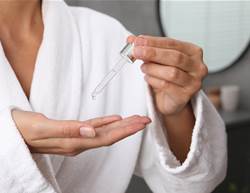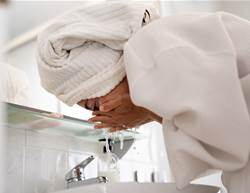The beauty market is more crowded than ever, making it tempting to experiment with and pile on products. But “more” can actually do more harm than good. Dermatologists delve into the risks of skincare excess and explain how to find a happy medium.
The saying “too much of a good thing” applies to skincare too.
“The prevalence of overuse is likely due to exposure to products on social media and elsewhere online without guidance from experts,” says dermatologist Dr Stacey Tull. This results in complex multi-step regimens, constantly trying new products and using formulas that don’t fit your skin needs, that are too strong or that contain ingredients that could be harmful together.

Signs that skincare has gone wrong
Whether or not you have sensitive skin, your complexion will sound the alarm when you’ve gone overboard. Here are telltale cues:
Irritation
“You may notice red patches – allergic contact dermatitis – or hives, and may experience minor pain [such as a burning sensation],” says dermatologist Dr Trisha Khanna.
Dryness
Signs that the skin’s natural protective barrier is damaged include dryness, peeling or flaking, itching and tightness, Dr Khanna adds.
Flare-ups
Overusing skincare can exacerbate underlying skin issues such as eczema and rosacea, Dr Khanna explains.
New breakouts
Layering on too many products or using formulas that are overly heavy or that contain pore-clogging ingredients can bring on or worsen blemishes.
4 ways to do damage control
You went too far, and it shows on your skin — it happens! Put out the fire (and prevent future flare-ups) with these pro tips.
1. Press pause
Give skin a reset: “Stop using your current products and switch to a basic regimen,” Dr Tull says. Look for the labels “hypoallergenic,” “fragrance-free,” “alcohol-free” and “noncomedogenic” (non-pore-clogging).
2. Stay calm
For immediate relief of irritation, apply a cold compress and a moisturiser that contains soothing ingredients such as ceramides, hyaluronic acid, aloe and oatmeal to the area. If symptoms persist, see a dermatologist.
3. Don’t mix actives
Going forward, avoid applying strong active ingredients like exfoliants, acids, retinol and benzoyl peroxide on the same day to prevent stripping skin of its protective barrier, Dr Tull advises.
4. Be cautious
Do a patch test before applying a new product all over your face, suggests Dr Khanna. Dab the formula on a hidden area of skin (like the jawline), then remove it after the standard time period; if a reaction occurs, stop using it.
Streamline your routine
To maximise skin health, and minimise side effects, take a cue from the “skin streaming” trend, which involves simplifying a regimen to just the essentials. Adhere to these dermatologist-recommended steps to keep any skin type balanced:
Cleanse: “Wash your face twice daily to remove impurities,” Dr Tull says. Choose a mild non-soap cleanser to mitigate irritation.
Try: La Roche-Posay Toleriane Caring Wash Cleanser
Moisturise: “Apply a face moisturiser every morning and night” to replenish and seal in hydration, Dr Tull suggests.
Try: Aveeno Skin Relief Moisturising Lotion
Protect: Sun protection is the most important daily step, Dr Khanna says. Opt for a mineral SPF that contains zinc oxide, which has skin-calming effects.
Try: Aspect Sun Tinted Physical SPF 50+









